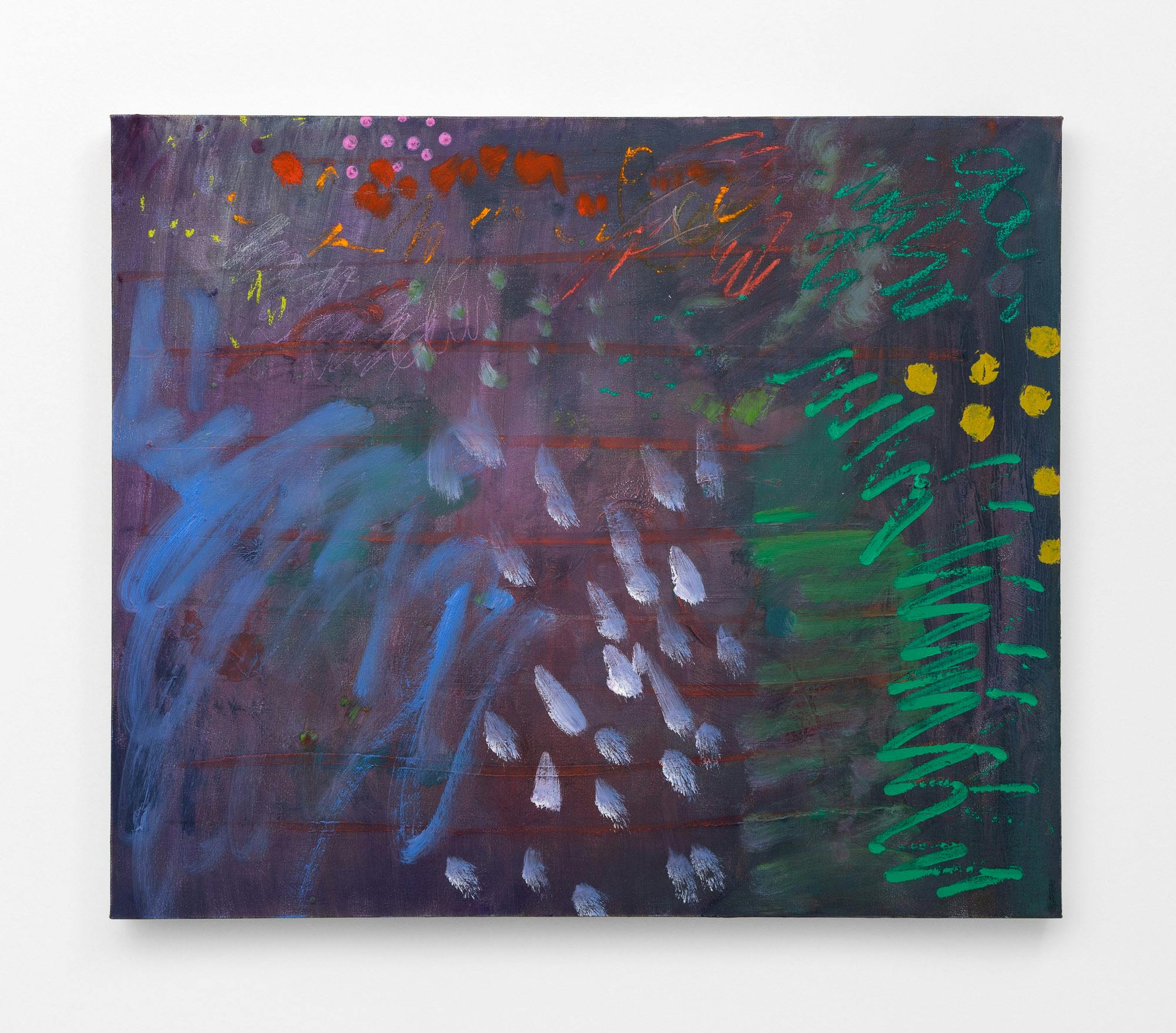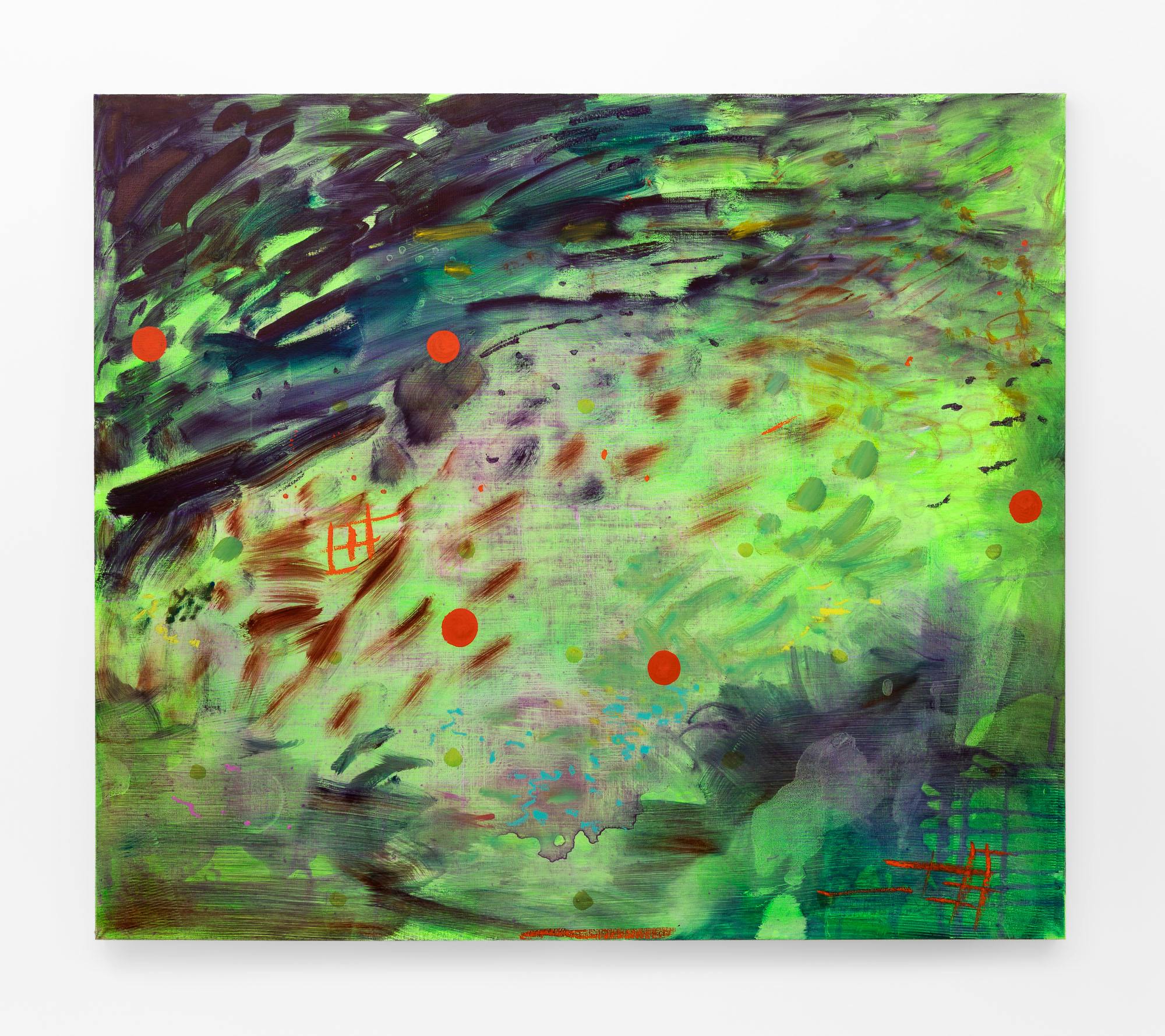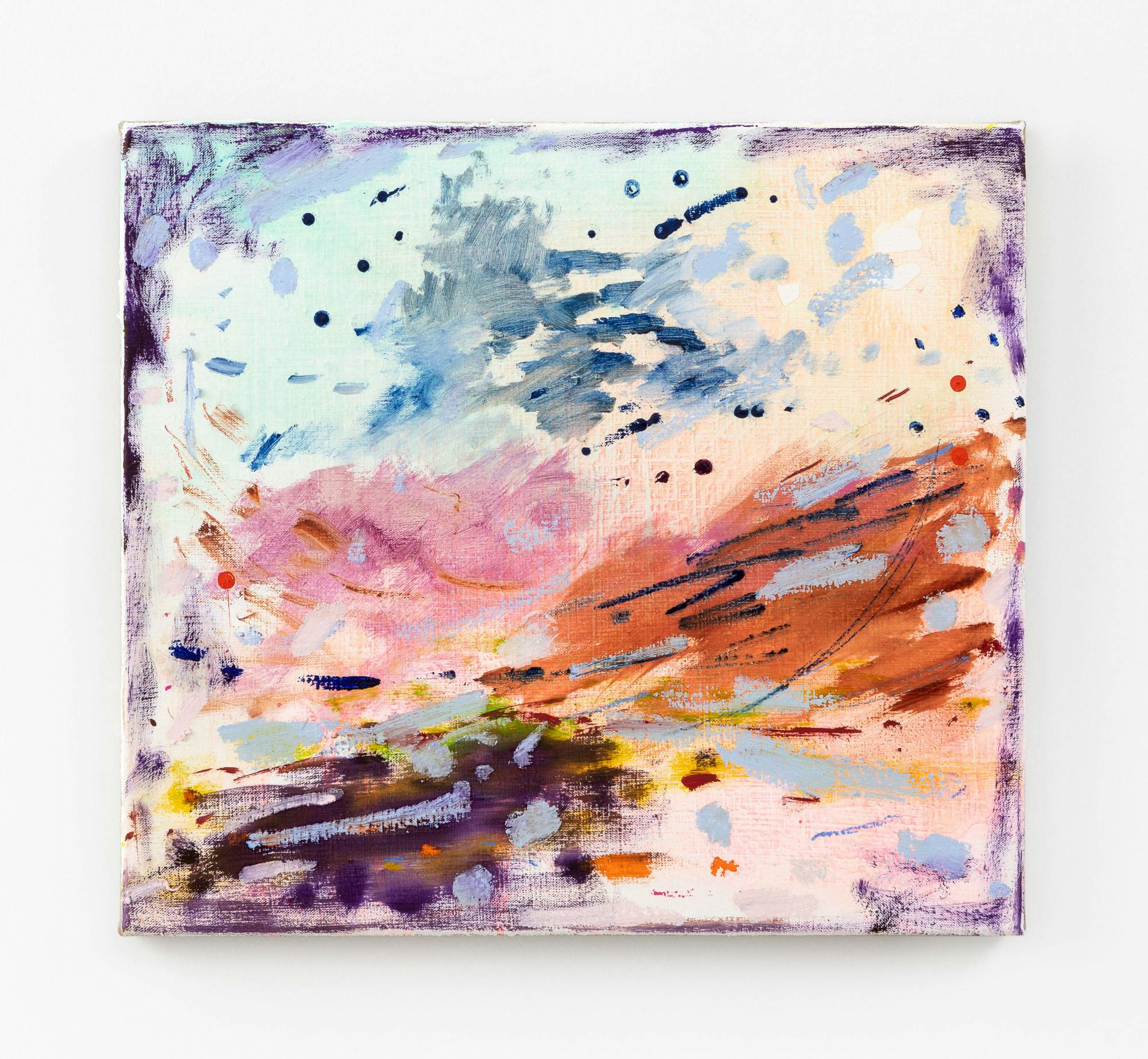Slippery Dance Floors & Somatic Promiscuities

Photo Credit
Emma McIntyre, 'Pour plenty on the worlds,' 2021. Installation view, Chris Sharp Gallery, Los Angeles, 2021. Image by Paul Forney.
Blushing effusions on exposed flesh beam with rubied modesty or perhaps a wholly welcome and well-placed slap. All of it slathered with so much confetti or dripping with ectoplasm, one wants to assume the latter.
A snowstorm of tulle over a smoky sunset. Each torn strip of gauzy colour as if Degas’ ballerinas went on strike, shredding their costumes into diaphanous hurricanes as they dashed and splashed into a midsummer river. Finally free from the tyranny of cruel masters and demanding spectators, their naked frolic is tucked just out of sight.
A genderqueer anchorite in the desert meets one of the gods they’re meditating upon at dawn and is granted a magical wrestling match between pure spirit and living flesh, a joyous tussle that intertwines slippery bodies with a hazy shimmer of soul (the kind of dream I imagine either of the desert Agneses, Pelton or Martin, might have early one morning).
Of course these scattered visions are really paintings by Emma McIntyre, mostly abstract with the occasional scrape of fingers or smack of her own body printed onto its layered hues. Originally from Aotearoa New Zealand, she’s found herself riding out these last days in California, a Fulbright Award ricocheting her through a second masters at the ArtCenter College of Design in Pasadena.
'Abstract' isn’t really the right word for her work to be honest, hasn’t been for many of the other magicians with a spirited, unstuck relationship to pigment (lest we forget the Guggenheim opened its doors as the Museum of Non-Objective Painting). Paintings so readily read as abstract are too viscous, corporeal, physical, smeary, and wet.
In philosophy, the term ‘abstract’ is sometimes employed to mean a drawing away from the physical world, but McIntyre’s paintings are much too physical for that old disembodied spectre. There’s certainly soul and the shapely ether of thought undulating like jellyfish in all this colour, but her work’s clear erotics give them a real body.

Photo Credit
Emma McIntyre, 'No One’s Rose,' 2020. Oil, oil stick and pastel on canvas, 20 x 24 in. Image by Paul Forney.
Each torn strip of gauzy colour as if Degas’ ballerinas went on strike, shredding their costumes into diaphanous hurricanes as they dashed and splashed into a midsummer river.
Pass through the thicket of abstraction with your limbs intact and you’ll find yourself forced to find a new word to describe that country you’ve stumbled into. For a show she had at Chris Sharp Gallery this year, the press release suggests the phrase ‘promiscuous abstraction’ which feels closer to the truth but still not quite right. I keep restraining myself from calling it ‘somatic painting’ but that’s probably rubbish too. Why anyone wants to give a new name to a branch of art, or even the idiosyncratic way one artist practices it, is perhaps evidence that whatever language we’ve been plugging along with through the last century isn’t quite doing the trick. Or perhaps more precisely, isn’t doing the trick for this writer.
But since it has long been called abstraction we’ll surely call what came before by that word. And McIntyre has surely passed through those thickets, though not only that particular wilderness of art. Histories and contemporaries unfold in her pictures: I feel the wash of embodied being of Moira Dryer, the unlikely colours and material fuckery of Sarah Cain. If I squint, they can look like JMW Turner imagining a space battle in the hot gas and spit of another galaxy. A few of her squiggles give the same totally unprepared-for delight I find in Twombly.
The artist cites many of her own references, Mary Heilmann for one, Florine Stettheimer (you can see it in the acid colour palette) and Odilon Redon (all those dreamy, swirling skyscapes). She wrote a masters thesis on Jutta Koether, Jack Whitten, and Carolee Schneemann, working past the limitations of the biographical (especially salient for female and BIPOC painters, she argues) and into a more radical space of aesthetic invention. Or as McIntyre writes, ‘they were sometimes disembodied, personal, and/or narrative, often non-linear, and always textural and sensorial.’ As much as McIntyre appears to layer methods and materials with underwashes, pours, smears, and prints, along with flourishing brushes and unlikely materials from denim to mesh, I feel her endeavoring for layering that’s, to use her words, ‘textural and sensorial’.

Photo Credit
Emma McIntyre, 'The problem of vivacity,' 2020. Oil, oil stick and acrylic on linen, 56 x 64 in. Image by Paul Forney.
If I squint, they can look like JMW Turner imagining a space battle in the hot gas and spit of another galaxy.
And I for sure see Emma McIntyre’s paintings flirt with Mary Heilmann’s unlikely grids, whose wavering lines and spilling chroma shiver with pleasure. Heilmann is not an unlikely godmother here. While the elder's colours and occasional grids beam with a clean, dancey joy, patterns that beckon you to boogie like a freshly polished dance floor, McIntyre’s are those dance floors at the end of the night: scarred with action, wet with effluvia, bearing (to snatch some poetry from William Blake) all the lineaments of gratified desire. If the straight lines of the chequered tiles seem to warp and waver, don't worry: it's just the key-bump of ketamine you did before the dj signed off.
I remember a rollicking punk show in a poorly ventilated basement, our collective sweat a foggy mist that poured in condensed rivulets down the windows and pooled in puddles so thick on the floor, the mosh pit was like a slip-and-slide. Totally gross and wildly liberating. Looking at the smudged and liquid harlequin of McIntyre’s painting, I'm warmly reminded of the stormy weather fevered bodies can summon, especially when slammed against the angles and grids, systems and controls, of industrial modernity.
In her masters thesis, McIntyre talks about Jutta Koether’s ‘bruised grids’ and a recollection the German artist had of Barent Fabritius’s ‘The Slaughtered Pig’ (1656). In Fabritius’s painting, the pig is of course some visceral slaughterhouse porn, hanging splayed open by the butcher’s precise violence, cut clean in its own gross way, whilst the marred terracotta floor underneath has the wet scrape of evidence that is the real mess and horror of an abattoir. In many of Koether’s grids, I see that slaughterhouse floor, but McIntyre’s clearly thought through all this in her own way, processed the power of that particular vision, and come out somewhere else particular to her own aesthetic vision, which looks like the chequered tiles at the end-of-the-night dance club; the midsummer revolution of ballerinas; a sunrise wrestling match between a devotee and a demigod.

Photo Credit
Emma McIntyre, 'Cythera,' 2021. Oil, oil stick and acrylic on linen, 16 x 18 in. Image by Paul Forney.
I'm warmly reminded of the stormy weather fevered bodies can summon, especially when slammed against the angles and grids, systems and controls, of industrial modernity.
When I went to her show at Chris Sharp Gallery in LA, I found myself really connecting with a petite painting hanging in the back. Perhaps it was a size that I could almost imagine affording and fitting into my little house, maybe it was the colours that whispered some vision of the Los Angeles sky at dusk that is so difficult to really see and almost impossible to capture the feeling of. The title of it is ‘Cythera’ (2020), which, in addition to being a Greek island (one of the rumoured places where Aphrodite/Venus came ashore after her sea foam birth), also finds itself as a name/place in the Jean-Antoine Watteau painting, ‘The Embarkation for Cythera’ (1717).
Watteau painted a lot of fêtes galantes (a category the French Academy invented just for him), apparently the intimate, outdoor parties/orgies all the aristocrats had after the death of Louis XIV and the chill grandeur of Versailles. ‘The Embarkation for Cythera’ is an outdoor party/orgy, or certainly the very beginning of one (the title bent a bit could be reframed as ‘En Route to Love’). Everyone still has their clothes on except for a dozen cupids and a statue of Aphrodite/Venus presiding, but you can tell it’s all about to explode in tangled limbs and joyous eroticism, the earthy ground, the engorged pinks of their silky gowns, the whispering pale roses budding along Venus’s statue with its pleased smile, and all those nudy cherubs hustling the crowd into the infinite stretch of sky; or, you know, the sublime infinitude of orgasm.
Flipping between the two different Cytheras (Watteau’s and McIntyre’s), I can feel the former’s inspiration in the latter. McIntyre’s rosy hues have a splash of Rococo delight in them but clearly not as keen on any particular allegory. I don’t know if it’s the spread of blues or the palette of the painting in total, but it feels outdoors, the open promise of sky with the wisps and pillows of wanton clouds.
Maybe in some corner of my soul seeing McIntyre’s ‘Cythera’ at the tail end of winter (LA winter, but still) and whilst still under quarantine, it appealed to some dream of my own fête galante. It sparked some whisper of possibility, a feeling that I wanted to hang onto, look at longer, connect with, and remember. Was it the memory of some outdoor delight, some distant orgy that made me desire to linger with its colour? Swap out Louis XIV for Covid-19, and perhaps it’s a dream that after whatever the fuck is happening now, there might yet be other orgies and parties to come.
About the Author
Andrew Berardini is a writer, editor, and curator from California. He has curated exhibitions at venues including MOCA-Los Angeles, Palais de Tokyo, Castello di Rivoli, and the Pavilion of Estonia at the 2019 Venice Biennale. Best known for his poetic and corporeal writing, Berardini has been a longtime contributor to Artforum. Since 2008, he has been faculty at the artist-run free school the Mountain School of Arts and has occasionally run a residency for art writers at the Banff Centre in Canada. A contributing editor at Momus and Mousse, he is the author of 'Danh Võ: Relics' (2016) and a forthcoming work on colour.
@AndrewBerardini / @andrewberardini
ArtNow Essays is independently commissioned by the editor. The views expressed on ArtNow Essays are the authors' and are not necessarily held by ArtNow.NZ, the commissioning editor, editorial advisory, participating galleries, APGDN, or Creative New Zealand. While this platform does not publish readers’ comments, constructive feedback is welcome. Send your feedback to essays@artnow.nz.